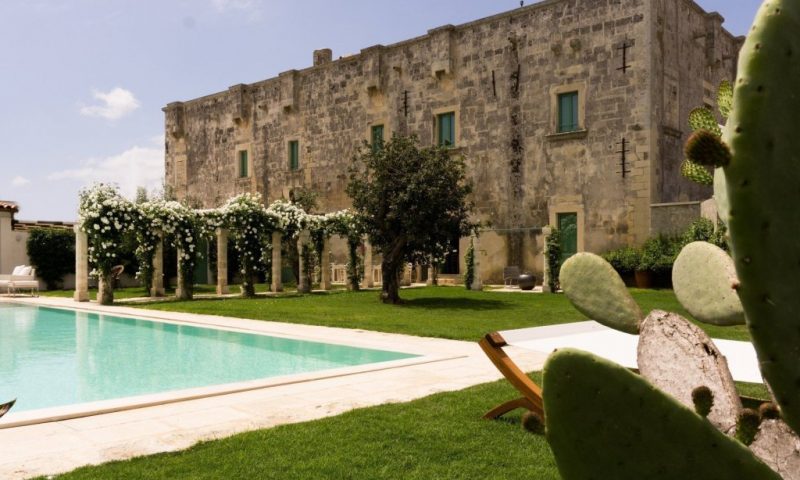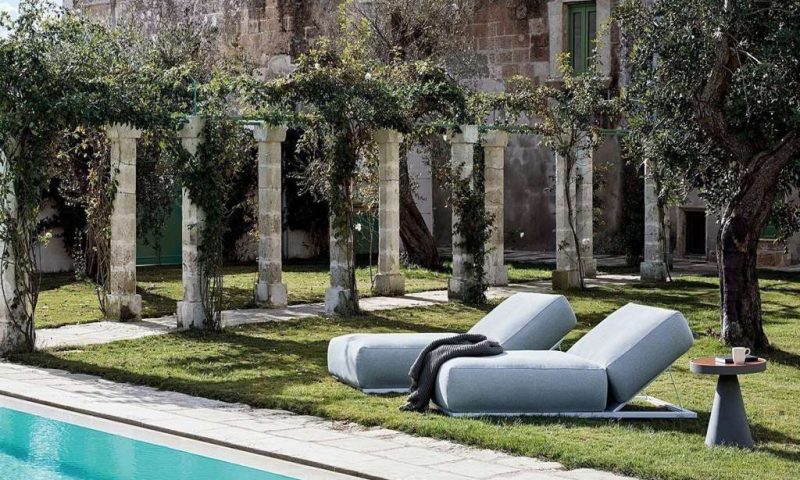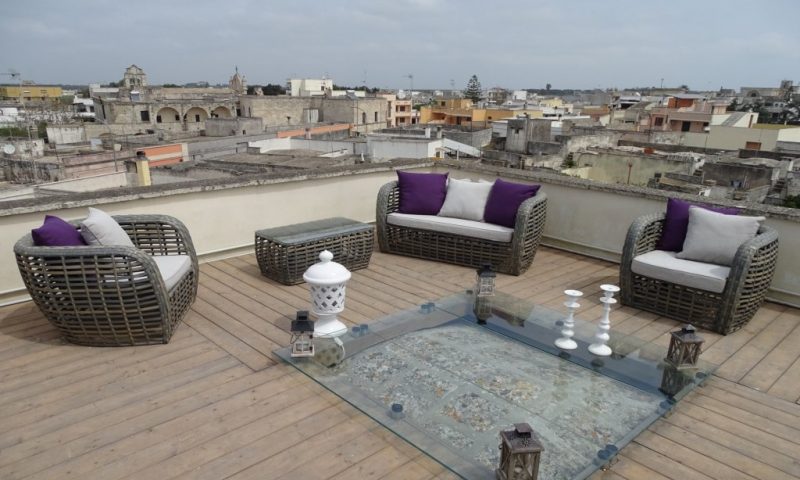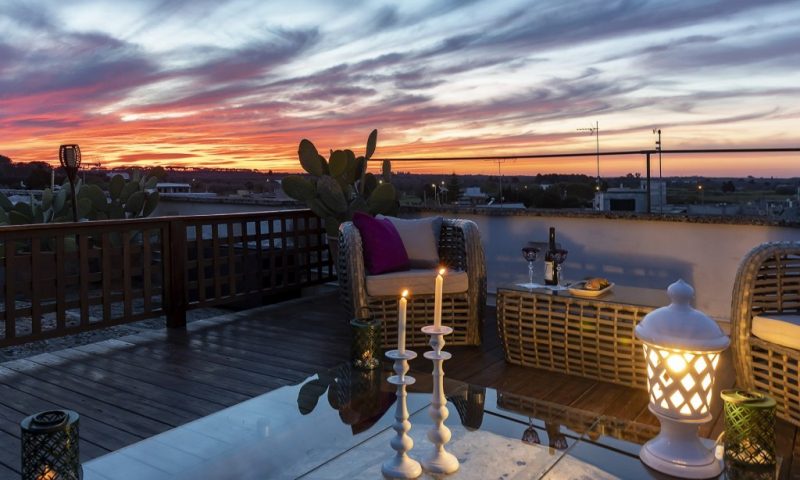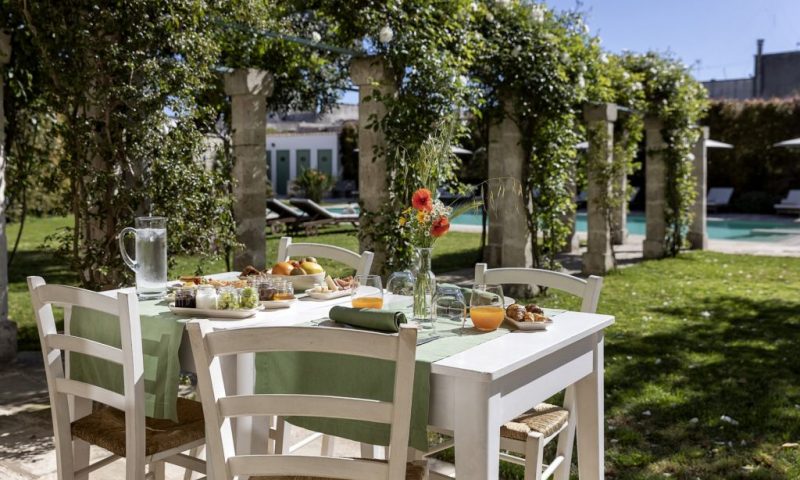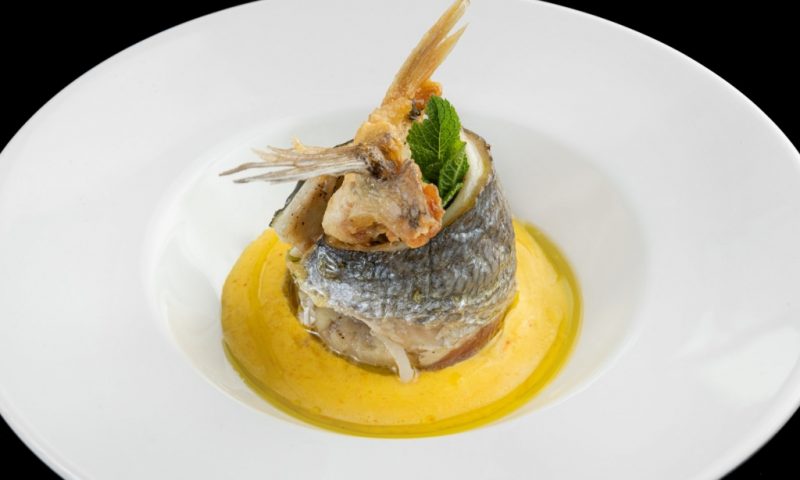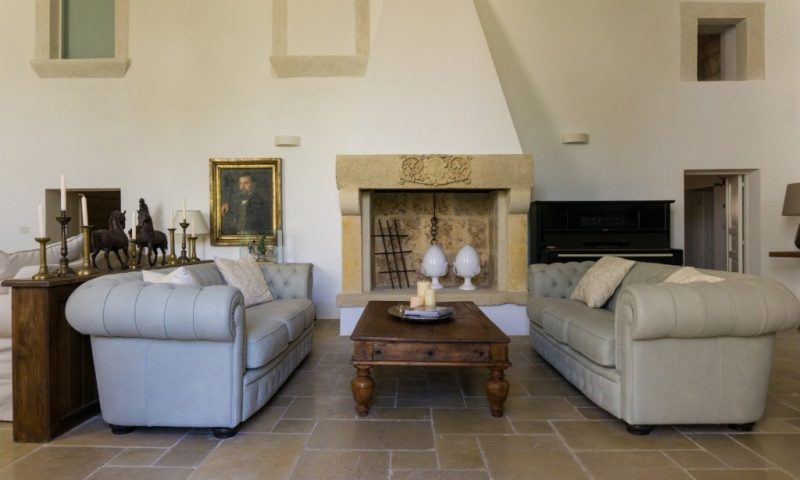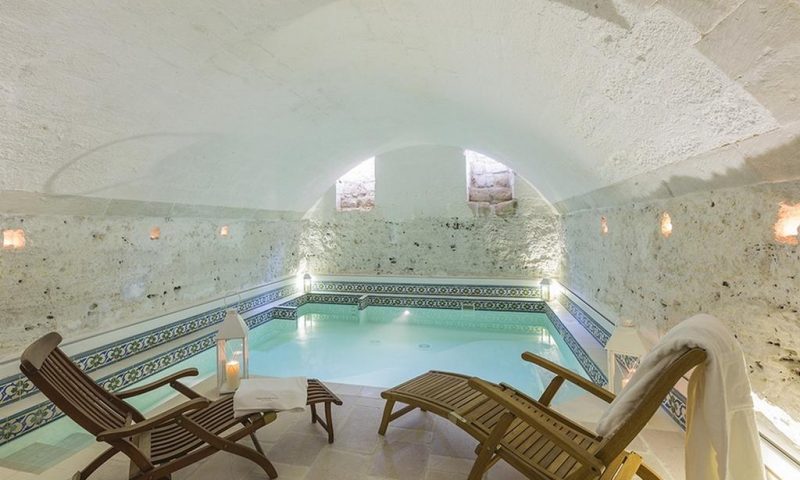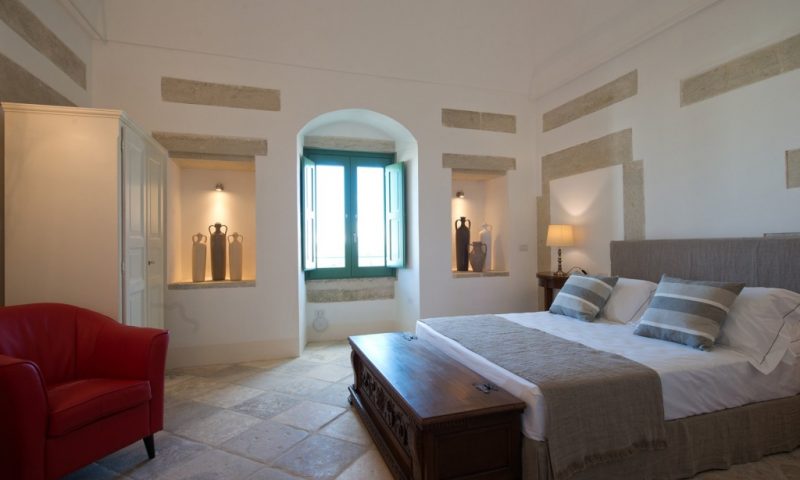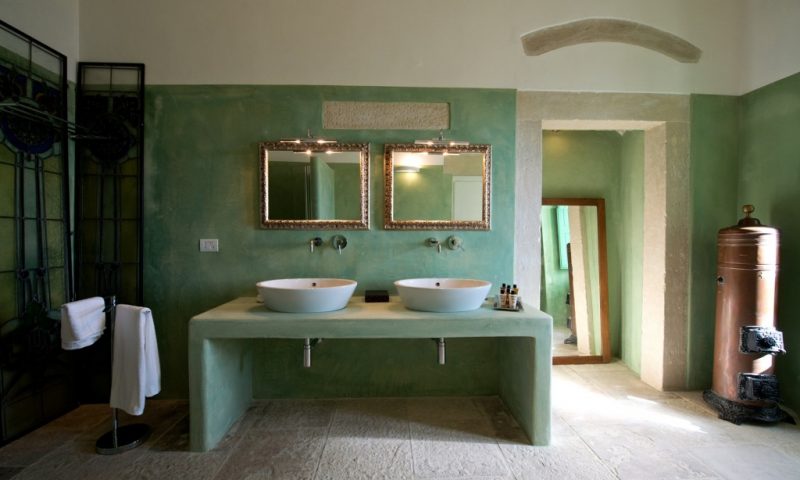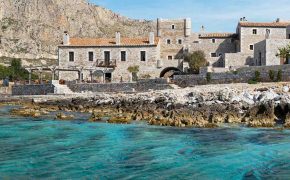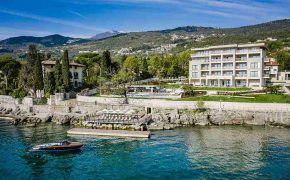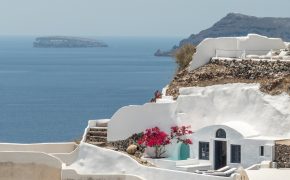Palazzo Ducale Venturi is a 5 Star Luxury Hotel in the heart of Minervino di Lecce, a quiet and peaceful borgo of Puglia. A place where the guests can enjoy an unforgettable stay immersed in history and, at the same time, surrounded by the many services such as the Wellness centre – including the unique pool converted from an ancient oil mill, the gym, the massage room, and the innovative cryosauna – the wonderful outdoor pool and the pool bar.
Our 5 Star Luxury Hotel is located in a 16th century noble palace, completely renovated under the supervision of the Superintendence of Cultural Heritage, recovering ancient salt ovens, Lecce stone star vaults and ancient chianche floors. Palazzo Ducale Venturi is an oasis of elegance, peace and beauty in a charming Relais for your holiday in Apulia, the ideal setting to stop in time sensations and unique moments.
Palazzo Ducale Venturi welcomes you with an exclusive setting for your special moments, a relaxing garden with pool, an incredible underground heated pool, a gym and a massage centre, a genuine breakfast based on local food and much more. We will take care of you whatever you desire.
THE DUCAL SUITE
On the ground floor, the Ducal Suite overlooks the main garden with pool. It owes its beauty to its 16th century frescoed ceiling showing Saint George and the dragon, its prestigious finishes and its antique furniture. The room has a private patio, two separate areas, and a large bathroom.
The room is approximately 45 sq m large. The other four Suites are on the two floors of the ancient Armoury, discovered after a deep study on the building and its history, and then completely restored. Besides the large spaces and the many comforts, the Suites show a meticulous care of the details which will bring the guest into the world of luxury and history.
JUNIOR SUITE
On the first floor of the Palazzo, and two on the two floors of the ancient Armoury, are characterized by wide and comfortable spaces enriched with furnishing details that are the result of a refined research. The Junior Suite brings back to life the aristocratic and sumptuous past of the Palazzo.
DELUXE ROOM
One on the ground floor and eight on the first floor, the Deluxe rooms are of different sizes and features, but, all of them, tastefully furnished in a special and unique way. They are equipped with a living area with two armchairs and a desk.
The Agrumeto rooms – One on the ground floor with a direct access and view over the citrus grove (on request, it can have an interconnecting room), and two on the first floor overlooking the garden, slightly smaller, but with large windows which allows the warm sunlight to flood the room.
Throgh their luxury finishes, the antique furniture, and a design based on nature’s nuances, they give unforgettable moments to live and tell.
LIVING ROOM
A unique place because of its ‘out of time’ atmosphere, because of its research in furniture, paintings, and ancient artifacts, because of the recovery of 2 salt wood oven brought to their former glory which will allow guests to discover ancient recipes of Salento and to learn how to prepare them.
SPA & WELLNESS
In the private SPA, an underground heated pool converted from an antique oil mill, with hydro-massage, relaxing music and dim light, the guest is completely cuddled. Guests can also choose among a wide range of facial and body beauty treatments, and different kinds of massages (classic, draining, sportive and relaxing), all with the most innovative methods and through the work our qualified personnel.
CRYOTHERAPY
Palazzo Ducale Venturi is the first 5 star luxury hotel in Puglia, and amongst the first hotel in Italy, with Cryotherapy. The cryosauna is an innovative system operating down to -190˚ for a whole-body treatment, which brings immediate benefits in just 3 minutes. Cryotherapy is an effective treatment for:
- BEAUTY, being a real non-invasive face-lift with a natural anti-ageing effect;
- HEALTH AND WELLNESS, improving sleep quality, reducing stress and chronical pains;
- PHYSICAL ACTIVITY, to get better performances and to recover muscles after exercise.
SWIMMING POOL
We made our pool with only your pleasure in mind. Crystal clear salted water for a peerless relax in our hidromassage or sippering a glass of champagne.
GARDENS
In our structure you find two gardens: the main garden, where the pool is located, and on which also overlook the gym and the bar; and the secret garden where you will find the peace to spend an evening surrounded by romantic citrus trees and the soothing sound of a fountain.
COOKING CLASS
Live your holiday in Puglia to the full. Book a Cooking Class with our Chef! Discover the ancient secrets of homemade pasta, Salento dishes, focaccia, pizza and biscuits to entertain even the youngest children!
LA DOLCE VITA
A classic car tour to explore the countryside and quiet villages surrounding Lecce or the Adriatic coast from Otranto to Castro in an iconic 1963 FIAT 500.In the countryside, lose yourself through endless olive groves and explore ancient underground oil mills. At sea, explore caves by boat and enjoy a sea-view lunch.
NATURAL WINE ENCOUNTERS
Start your day exploring Lecce baroque jewel, old town center and artisan shops on a friendly and informative walk and continue with a short drive to the heart of natural wines, to earn more about this artisanal production which lies in organic grapes, and wines spontaneously fermented in clay.
Your trust will be rewarded with a private encounter, tutored tasting and lunch at the vigneron & wine maker private house, to delight your senses indulging in an exclusive and private setting away from the tourist crowd.
THE BAROQUE ART
This unique tour of Lecce will open the doors of private artist studios, designer and nobility, offering an overview of Lecce combined with exclusive local encounters.
A friendly walk with a special focus on local artists, a unique opportunity to understand more about the local stone, that made the baroque architecture of Lecce so unique and fascinating, while sharing an aperitivo with a local artists and designers at their private studios, and learn how the stone can influence various works of art from sculpture to photography and paintings while touring Lecce with your local guide.
THE ICONIC FIAT 500
Explore Lecce old town on board of 1963 convertible Bianchina or classic Fiat 500, and lose yourself in the maze of alleys of this amazing baroque jewell, with your local guide and friend.
A complete introduction to the history and main monuments of the town with plenty of tastings and tips for further exploration and independent sightseeing and dining. A city tour that will make your senses tingling offering a new perspective on the old town.
LECCE FOOD TOUR
A leisure stroll of Lecce old town where streets are paved with taralli and churches made of Marzipan. A friendly yet informative walk between local delights and baroque extravaganza, designed to be tasty and fun, combining an overview on Lecce history, main monuments and points of interest with several food and wine tasting guided by our sommelier and food expert, for a complete introduction to the history and the town, its products and culinary heritage, with many tips for independent dining and further exploration.
PRIVATE BOAT TOURS
Enjoy the coastline, the sun, the sea and the unspoilt bays on a private boat tour with lunch on board prepared by the captain.
QUARRY & STONE EXPERIENCE
A day out of the ordinary to immerse yourself in one of Puglia’s oldest traditions. The Lecce stone typical of this area is soft and very easy to work, making possible the stunning Baroque style for which the city of Lecce is known.
You can explore the subterranean, lunar landscape of the stone quarries and be an apprentice stonemason for a day. Followed by a master and equipped with a chisel, you will learn how to transform a block of stone into a unique work of art.
THE ART OF CERAMICS
If you love art and ceramics, this unique experience is just for you: a ceramics workshop with a local craftsman at your complete disposal! You will learn the secrets of working with clay and you will be able to create your own masterpiece in the heart of Lecce’s historic centre.
SALSA MAKING
There i s not better way to dive i nto tradition than making “SALSA”, the deep red home made tomato sauce that every year i s traditionally made in Puglia, when the fiaschetto tomatoes are ready to be harvested. An authentic family tradition.
TREKKING, BIKING & KAYAK
Explore the wildest stretch of the Adriatic coast and enjoy breathtaking views as far as Otranto, Italy’s most estearn city. Or book a bike tour to visit Salento’s vineyards and taste their wines; local dairies to learn the secrets of mozzarella and burrata production and much more!
And why not dive into the crystal-clear waters by kayaking and exploring the coastal caves and hidden coves of the Adriatic with a marine biologist to learn more about Puglia’s ecosystem?
YOGA CLASSES
If you feel you need to dedicate a moment just to you, if you are looking for a place of peace and tranquillity, where you can regain the balance you feel you have lost, Palazzo Venturi is the ideal place.
Our yoga teacher will guide you on a journey of inner rediscovery, of achieving harmony between body and mind, of reconciliation with the world around you in the peace and tranquillity of our enchanting citrus grove.
THE LUXURY OF TELLING AN IMPORTANT STORY
It is one of the first Ducal houses of Salento to open its doors and welcome guests in the sumptuous and aristocratic world of five centuries of history, art and culture.
THE MISTERY – THE ABBESS
According to the legend, the Duke Venturi of Minervino had a great passionate love story with the abbess of the village’s Monastery, who built a secret underground tunnel to connect the Monastery to the Palace, so that they could meet. Although their ‘love story’ went on for years, one day the duke fell madly in love with a young novice who came from a Neapolitan noble family.
The Abbess, consumed with jealousy, drugged the novice and buried her alive inside the underground tunnel, walling it up and closing it with a door of the city of Otranto prison (this door was found 10 feet beneath the surface during the restoration work for the underground pool).
Furthermore, the abbess wanted the duke to wall the lovers’ alcove up, the place where the two were used to meet. The woman lost also her faith to such an extent that cursed the duke’s bedroom with the formula ‘hic amor mori’, here love died.
The curse was later lifted and the evil forces were driven out by Saint Eligio. Tradition, legend, true or false? The owners decided to recreate the cursed room putting the antique door, found during the restoration work, back in its original place.
THE DISCOVERY – SANT’ELIGIO
Around mid-sixteenth century, Saint Eligio, returning from a pilgrimage to the Holy Land, stopped in Apulia. He heard about the legend of the abbess of Minervino and decided to visit the historical Palace of Duke Venturi.
Even though no one was there, the door was open, and as soon as he walked in, the devil showed up, dressed like a woman: Saint Eligio rapidly grabbed him by the nose with tongs. And since then the abbess’s curse disappeared.
This coloured legend is depicted in two French Cathedrals (Angers and Le Mans) and in the Duomo in Milan, with the stained glass window by Niccolò da Varallo, donated by Milanese goldsmiths in 1400.
The historic Eligio, son of quite modest people, must have had an education at some point, because he was hired as an apprentice by the Lyon’s goldsmith Abbone, who also managed the royal mint: a great master in his art.
And the apprentice Eligio became no lesser than his master. Because of his fame with his art and the fact that he was a perfect gentleman, there is actually an interesting story, unfortunately not documented, which tells that King Clotario II commissioned him a gold throne, giving him the necessary materials.
He was so good that from the given amount he managed to create two thrones and therefore managed to half the estimated price; something which had never been heard of before.
King Clotario made Eligio head of the mint in Marseille, while he continued to be a goldsmith. When the new King Dagoberto came to the throne he was called to court and changed his job; the King made him his Ambassador, in delicate matters with missions of trust.
Eligio decided other assignments by himself: for example, he redeemed war prisoners with his own money, he founded both male and female monasteries. When the king died, he decided to live a religious life and was consecrated Bishop of Noyon-Tmournai.
He started a new life. Eligio undertook the evangelizing campaign (and re-evangelizing) in the North of Gaul, in the regions of the Meuse and in the Scelda, in the land of the Frisians.
He became a protagonist with other bishops such as Audoeno (Ouen) of Roauen (who became his biographer), Amand of Tongres, Sulpizio and the Pious Bourges. He died on Dutch soil, from where his remains were brought back to Noyon only in 1952. And this is when the other story of Saint Eligio starts: his cult spreads through France, Germany and Italy.
They all want him as a patron not only the goldsmiths, but practically all the craftsmen for metal, carters, garbage collectors, horse traders, farriers and even in more recent days, mechanics. In some places in France they bless the horse on his remembrance day.
Even today in Vitigliano, a small village close to Minervino, between the 4th and 6th of December, there are customs and festivals of antique cult, rites and traditions.
A useful occasion to know, remember and re-live rites and cults of the past and help the younger generation to approach religious practices developed in the area. At Palazzo Ducale Venturi, we found and brought to life 2 rings that were used to tie sick horses and pray to Saint Eligio, the depiction of which – according to testimonies of local elders – was inserted in the right hand niche on the front of the Palace.
THE PRINCESS – ROYAL BLOOD
The legendary life of Giorgio (born in Cappadocia), recruited in the roman army, does not explain why he left the military life to take a journey to Alimini in Apulia, where a fierce dragon lived in a lake.
The monster often visited the local town and with a malefic blow killed the people and then ate them. So then the locals decided to bring him two sheep each day so that he would not continue to massacre the citizens. But when they started to run out of sheeps, the King decided to send a sheep and a youth chosen at random.
The day in which Giorgio arrived in Alimini on his horse, the choice fell on the king’s only daughter. The king offered half of his lands and all of his wealth for his daughter to be saved, but the people accused him because it was he himself who had established the rules and therefore could not evade the commitment. (You can see in the fresco on the vault of our suite, the offerings in the form of shards and Apulian vases).
The young princess crying and dressed in her royal robes, was making her way to the lake whilst the crowd watched her from the walls of the city. Giorgio arrived at that moment, and asked her the reason for her desperation.
She implored him to leave should the dragon swallow him up too. But he went directly towards the dragon and injured it with his spear. Then he ordered the maiden to take his belt and put it around the dragon’s neck and take it back to the city.
The twenty thousand people present and the king himself, saw the prodigy, and fell to their knees. Then Giorgio with his sword killed the dragon. The king asked him what he wanted in return for what he had done, and Giorgio replied that he was in love with the Princess and wished to marry her.
The princess wonderfully happy took knight Giorgio’s hand and said that she also was in love and wished him to be her husband. Knight Giorgio and the Princess Alena left on his horse and their traces were lost forever from all the history books and ecclesiastical records.
After more than 200 years, Giorgio as if by magic returned to the history books as Saint Giorgio, who killed the dragon, which represented Evil. History, legends, myths, saints and mysteries, one thing is certain LOVE ALWAYS CONQUERS ALL.
This story, probably around IX-X century, accompanied the ancient tale of the tortures of Saint Giorgio and spread through western Europe. The Duke Venturi and his wife were fascinated by this legend and gave an artist the task of bringing it back to life on the walls and roof of the Palace. Today it can still be seen on the ceiling of the bedroom in the suite of Palazzo Ducale Venturi.
THE ORIGINS – THE DUKE VENTURI
Venturi Palace is an austere structure of the sixteenth century that can be considered a real fortress. It is on two floors, and you can see machicolations by the windows and the entrance door, used to defend the building from foreign attacks. The ashlar worked gate with the Venturi emblem displayed above has a remarkable artistic value. Many different theories exist on the origins of the name “Minervino”.
According to some researchers, the name comes from an ancient temple dedicated to the roman goddess Minerva. Another theory says that it was built up in memory of the old Castro, once called “Minervium”, destroyed by the Saracens around 1266.
The most plausible theory is that Minervino has Roman origins, and this is confirmed, not only by the presence of old remains of that historical period, but also by the recovery of a street, the paving of which is very similar to that of Via Appia, which connected Rome to Brindisi.
Minervino grew in population in the first decades of the 1500s: in 1532 it had 95 families, equivalent to around 475 inhabitants; it was a feud of the Filomarinis, dukes of Cutrofiano, until 1619, when the land was bought by the Venturis, who later on became dukes.
Up to 1650 Minervino was divided in 16 hamlets, each hamlet had from 50 to 100 inhabitants; actually, these hamlets were just “masserie”, a kind of manor farms, typical rural buildings, the most important of which was called “Borgo Minervino”.
The historical division into hamlets is the evidence of the Greek-Byzantine past of this city. With no doubt Minervino is involved in the megalithic phenomenon. This is not proof of its Messapian origins, but shows the existence of extremely ancient populations.
The most significant example is a dolmen called “Li Scusi”. This is an enormous monolithic block sustained by vertical blocks by the sides and considering the tools that were used in that period, there must have necessarily been an organized society to build it up.
Minervino was often threatened by many Saracens raids, and, to defend itself, a guard tower was bought (the one between Otranto and S. Cesarea), tower still named like the “universitas” that raise it up.
Minervino is one of the traditionally most wealthy villages. According to documents of 1600-1700, the income of people from Minervino was higher than that of people from the surrounding villages. This is why the inhabitants of Minervino were called “Capiddruzzi”, which means haughty people.
It is confirmed that in the XV century Minervino owned a castle and defensive walls, it was a prosperous centre, so that on the church dedicated to S. Pietro was engraved: “comu lu lione ete lu re te li animali, cusì Minervino ete lu re te sti casali” (just as the lion is the king of the animals, so Minervino is the king of these hamlets).
Actually, the village was particularly flourishing from the XV century until the first half of the XX century. The civilian and military buildings and the amazing church show the importance of this place and reveal its elegance.
Many are the buildings with remarkable architectural value: Palazzo Scarciglia, extremely refined, with its gate and inner court where you can still find amazing capitals. The majestic Palazzo Ducale Venturi, instead, is a real castle, adapted into a noble dwelling.
In the main front you can see a big gate and the machicolations cover every access on every side. In the surrounding areas you can see the fortified manor farm S. Giovanni, with a sixteenth-century tower.
The most important among the religious buildings is the Chiesa Matrice (XV-XVII century). Built close to the square, it strikes for the beauty of its rosette. The interior, richly furnished, is as precious as the main façade. The amazing side door is remarkable, too, with the statue of archangel Michael, to whom it is dedicated.
Finally, of great importance are also the Chiesa Dell’Addolorata (XVII century), with its stucco decorated vault; the Chiesa di S. Antonio (XVI century) where the high altar contains a canvas by Catalano; the Chiesa di S. Maria Delle Grazie (XVI century) with the amazing inner vaults and the higher altar in Baroque style; the Chiesa di S. Pietro and the Chiesa di Santa Croce.
